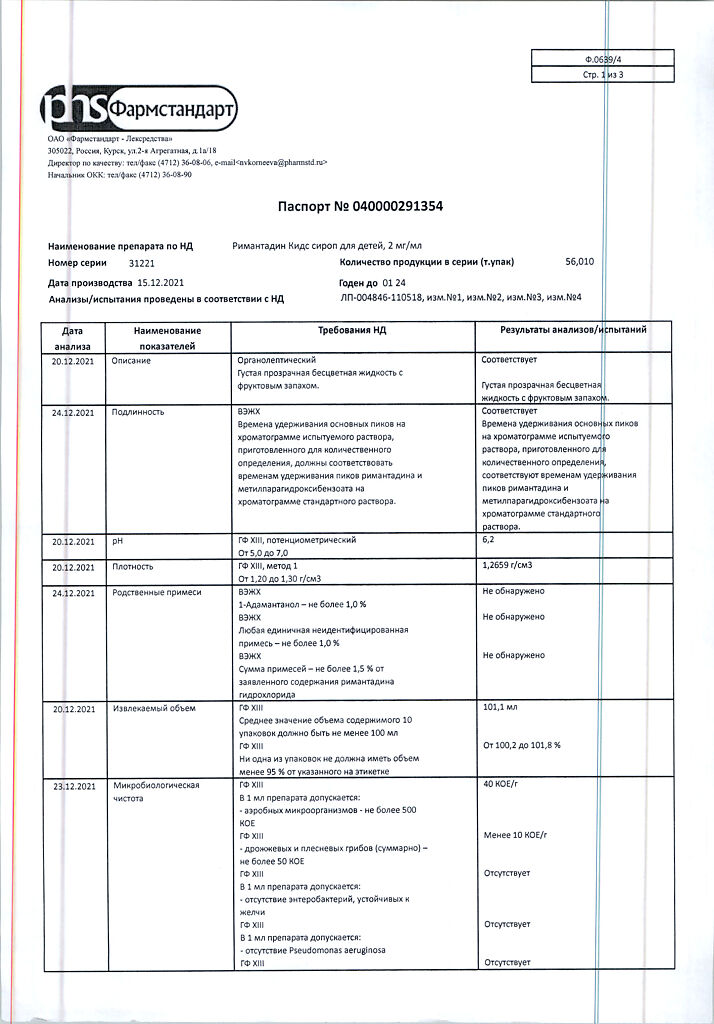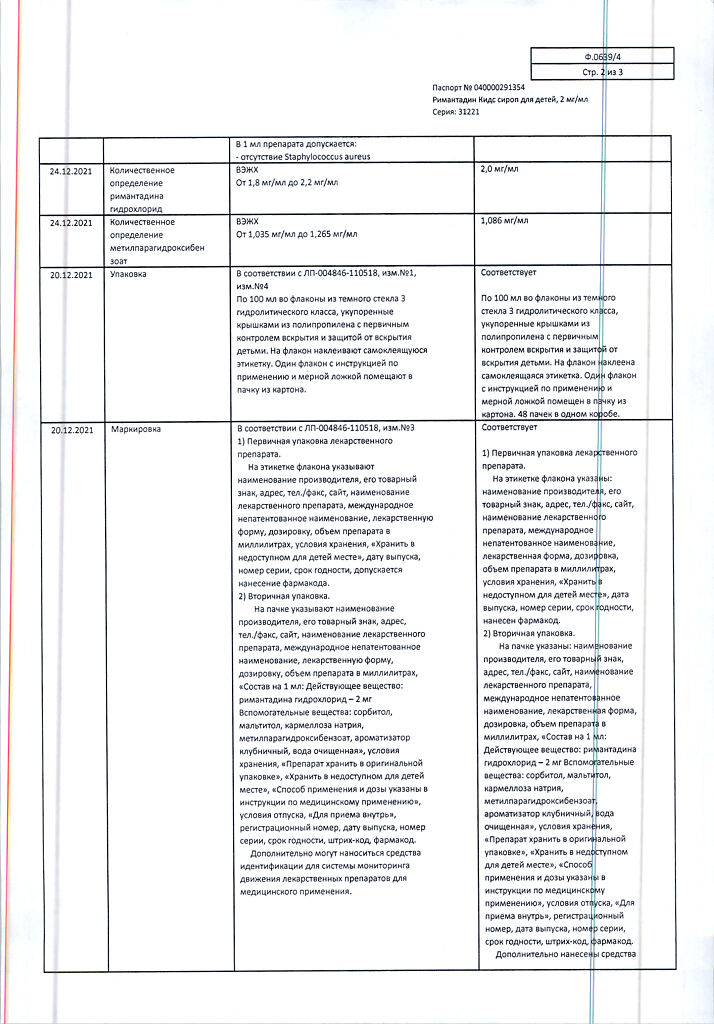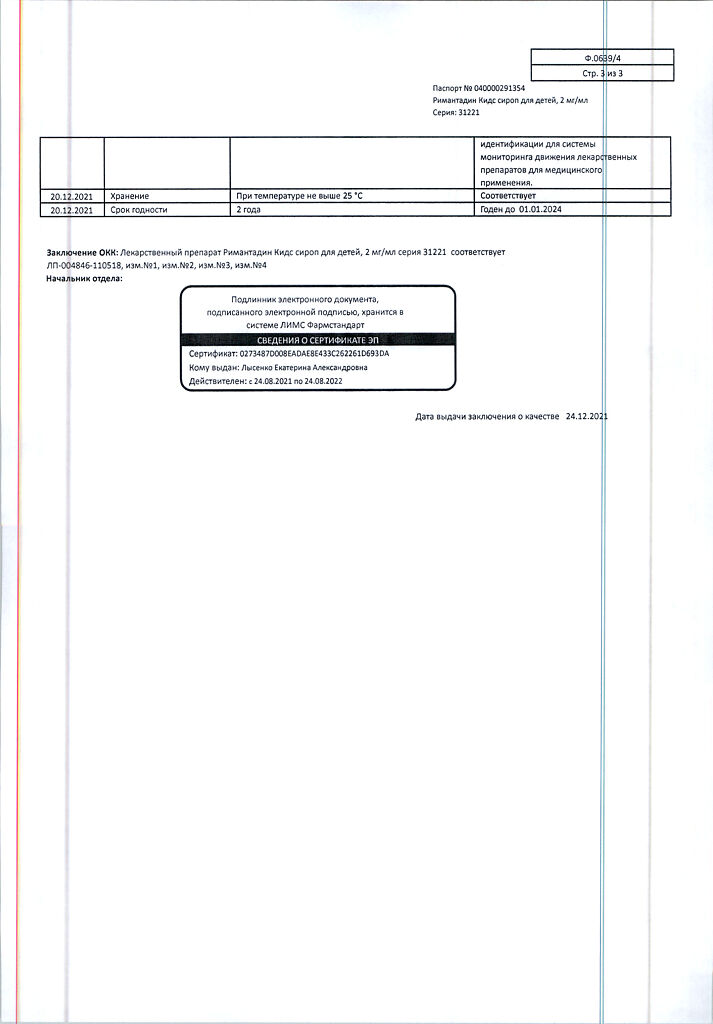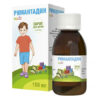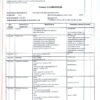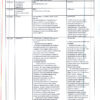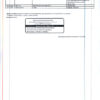No products in the cart.
Description
Rimantadine is an antiviral agent derived from adamantane; it is active against various strains of influenza A virus. Being a weak base, rimantadine acts by increasing the pH of endosomes, the membrane-containing vacuoles that surround viral particles after they enter the cell. Preventing acidification in these vacuoles blocks the fusion of the viral envelope with the endosome membrane, thus preventing the transfer of viral genetic material into the cell cytoplasm. Rimantadine also inhibits the exit of viral particles from the cell, i.e. it interrupts the transcription of the viral genome.
Indications
Indications
Prevention and early treatment of influenza A in children over 1 year of age.
Prevention with rimantadine can be effective during contact with sick people at home, during the spread of infection in closed groups and at a high risk of developing the disease during an influenza epidemic.
Pharmacological effect
Pharmacological effect
Rimantadine is an antiviral agent derived from adamantane; active against various strains of influenza A virus. Being a weak base, rimantadine acts by increasing the pH of endosomes, which have a membrane of vacuoles that surround viral particles after they penetrate the cell. Preventing acidification in these vacuoles blocks the fusion of the viral envelope with the endosome membrane, thus preventing the transfer of viral genetic material into the cell cytoplasm. Rimantadine also inhibits the release of viral particles from the cell, i.e. interrupts transcription of the viral genome.
Special instructions
Special instructions
The use of rimantadine for 2-3 days before and 6-7 hours after the onset of clinical manifestations of influenza type A reduces the severity of symptoms of the disease and the degree of serological reaction. Some therapeutic effect may also occur if rimantadine is given within 18 hours of the onset of flu symptoms.
When used, exacerbation of chronic concomitant diseases is possible.
In patients with epilepsy, the use of rimantadine increases the risk of developing an epileptic seizure. 15 ml of syrup corresponds to 1 bread unit (XU), which should be taken into account when prescribing the drug to patients with diabetes.
Viruses resistant to the drug may emerge.
Sorbitol may cause abdominal discomfort and have a laxative effect. If such effects develop during treatment, you should stop taking the drug and consult a doctor.
Due to the increased risk of dyspeptic symptoms, simultaneous use with foods containing sorbitol in significant quantities (prunes, etc.) is not recommended.
Impact on the ability to drive vehicles and machinery
Considering the likelihood of developing side effects from the central nervous system, care should be taken when driving vehicles and machinery.
Active ingredient
Active ingredient
Rimantadine
Composition
Composition
Active ingredient:
rimantadine hydrochloride – 2.0 mg.
Excipients:
sorbitol (liquid sorbitol) – 514.3 mg,
maltitol (maltitol liquid) – 514.3 mg,
carmellose sodium – 3.64 mg,
methyl parahydroxybenzoate – 1.15 mg,
strawberry flavoring – 0.63 mg,
purified water – up to 1 ml.
Pregnancy
Pregnancy
The use of the drug is contraindicated during pregnancy. If necessary, use during lactation should stop breastfeeding.
Contraindications
Contraindications
Acute liver diseases;
acute and chronic kidney diseases;
thyrotoxicosis;
pregnancy and breastfeeding;
children under 1 year;
hypersensitivity to rimantadine and the components of the drug;
sucrase/isomaltase deficiency;
glucose-galactose malabsorption;
fructose intolerance.
With caution
Epilepsy (including history), severe chronic renal failure, liver failure, diabetes mellitus.
Due to the presence of sorbitol, it should be taken with caution in case of vomiting, pain and discomfort in the abdomen, and diarrhea.
Side Effects
Side Effects
From the cardiovascular system: tachycardia, heart failure,
heart block, palpitations, arterial hypertension, cerebrovascular accident, loss of consciousness.
From the nervous system: insomnia, dizziness, headache, irritability, fatigue, impaired concentration, movement disorders, drowsiness, depressed mood, euphoria, hyperkinesia, tremor, hallucinations, confusion, convulsions.
From the senses: tinnitus, change or loss of smell.
From the respiratory system: shortness of breath, bronchospasm, cough.
From the gastrointestinal tract: nausea, vomiting, loss of appetite, dry oral mucosa, abdominal pain, diarrhea, dyspepsia.
From the side of the track and subcutaneous tissue: rash.
Other: fatigue.
Interaction
Interaction
Pharmacodynamic: rimantadine reduces the effectiveness of antiepileptic drugs.
Pharmacokinetic: adsorbents, astringents and coating agents reduce the absorption of rimantadine.
Urine acidifying agents (acetazolamide, sodium bicarbonate, etc.) increase the concentration of rimantadine.
Paracetamol and ascorbic acid reduce the maximum concentration of rimantadine in blood plasma by 11%.
Cimetidine reduces the clearance of rimantadine by 18%.
The sorbitol contained in the drug may affect the bioavailability of concomitantly used medications.
Due to the increased risk of dyspeptic symptoms, simultaneous use with other medications containing sorbitol is not recommended.
Overdose
Overdose
In some cases, when the recommended dose is exceeded, the following are observed: tearing of the eyes and pain in the eyes, frequent urination, fever, constipation, sweating, inflammation of the oral mucosa, dry skin.
Treatment: gastric lavage, symptomatic therapy: measures to maintain vital functions. Rimantadine is partially eliminated by hemodialysis.
Recommendations for use
Recommendations for use
Treatment regimen:
Take orally (after meals), with water, according to the following scheme: for children from 1 to 3 years old – on the first day, 10 ml (2 teaspoons) of syrup (20 mg) 3 times a day (daily dose – 60 mg); Days 2 and 3 – 10 ml 2 times a day (daily dose – 40 mg), day 4 – day 5 – 10 ml 1 time a day (daily dose – 20 mg).
Children from 3 to 7 years old – on the first day – 15 ml (3 teaspoons) of syrup (30 mg) j times a day (daily dose – 90 mg); Days 2 and 3 – 3 teaspoons 2 times a day (daily dose – 60 mg), day 4 – day 5 – 3 teaspoons 1 time a day (daily dose – 30 mg).
Children from 7 to 10 years old: 25 ml (5 teaspoons) of syrup (50 mg) 2 times a day for 5 days (daily dose: 100 mg).
Children from 11 to 14 years old: 25 ml (5 teaspoons) of syrup (50 mg) 3 times a day for 5 days (daily dose – 150 mg).
Preventive scheme:
For prevention use:
children from 1 to 3 years old – 10 ml (2 teaspoons) of syrup (20 mg) 1 time per day,
children from 3 to 7 years old – 15 ml (3 teaspoons) of syrup (30 mg) 1 time per day,
children over 7 years old – 25 ml (5 teaspoons) of syrup (50 mg) once a day for 10-15 days.
Attention! The daily dose of rimantadine should not exceed 5 mg per kg of body weight.
Storage conditions
Storage conditions
At a temperature not higher than 25 ºС.
Keep out of the reach of children.
Shelf life
Shelf life
2 years. Do not use after the expiration date stated on the package.
Manufacturer
Manufacturer
Pharmstandard-Leksredstva, Russia
Additional information
| Shelf life | 2 years. Do not use after the expiration date stated on the package. |
|---|---|
| Conditions of storage | At a temperature not higher than 25 ºC. Keep out of reach of children. |
| Manufacturer | Pharmstandard-Leksredstva, Russia |
| Medication form | syrup |
| Brand | Pharmstandard-Leksredstva |
Related products
Buy Rimantadine Kids, 2 mg/ml syrup 100 ml with delivery to USA, UK, Europe and over 120 other countries.


